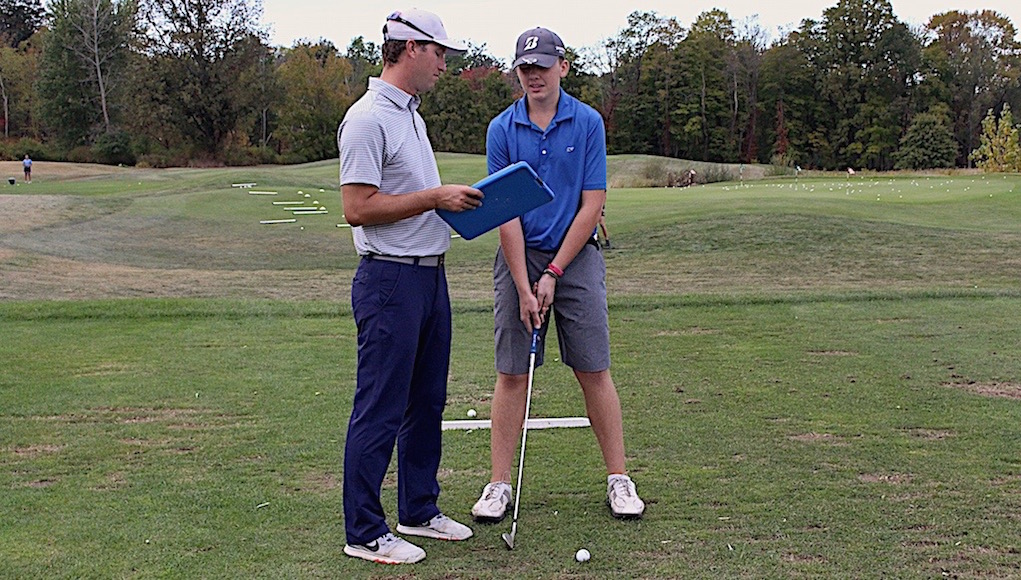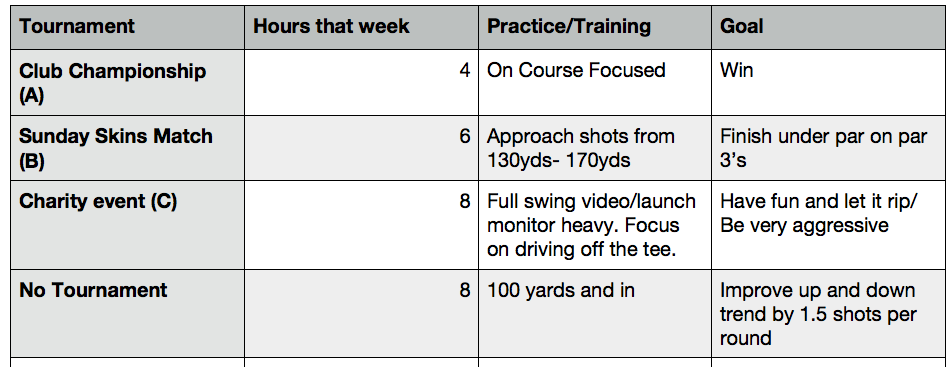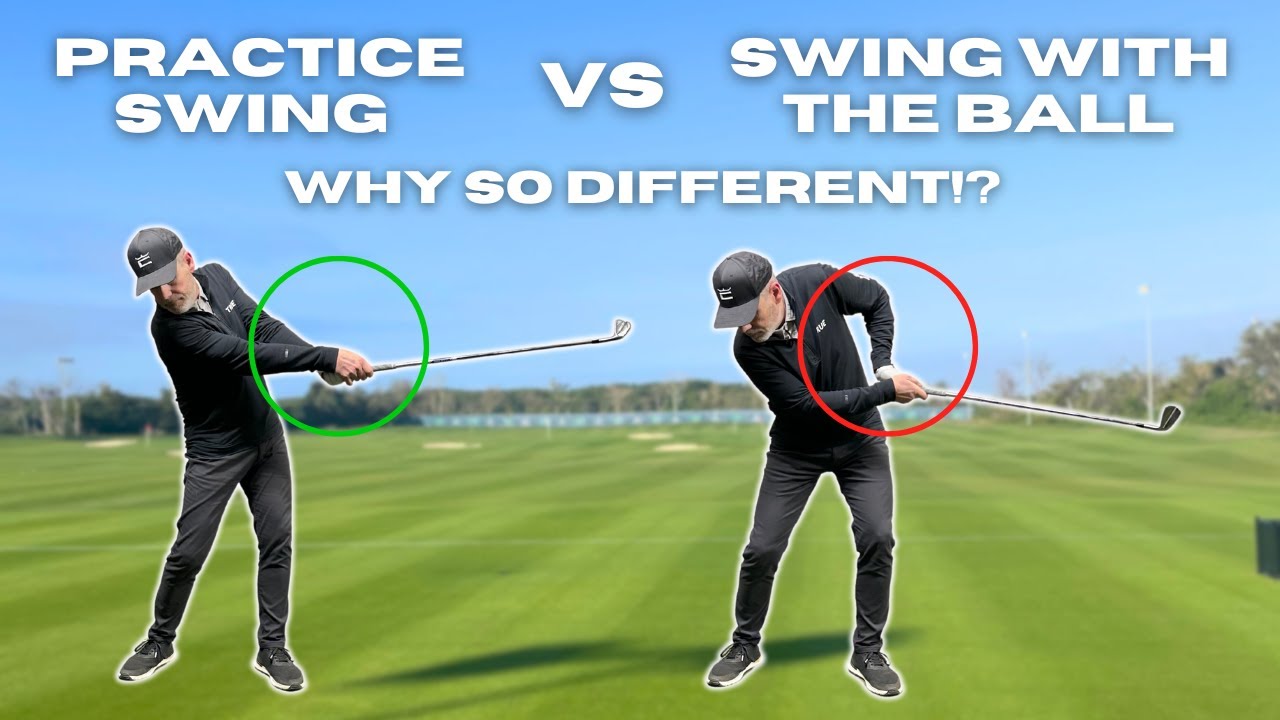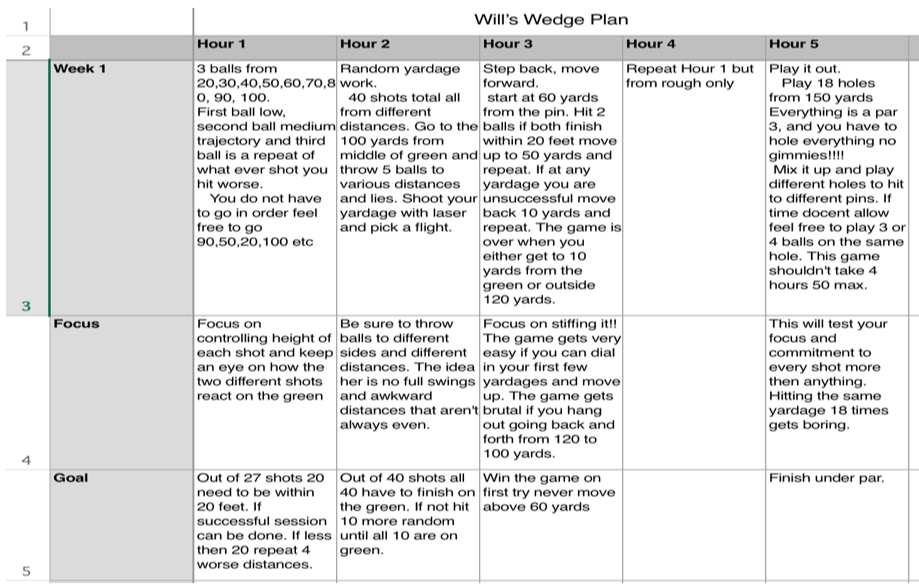Instruction
How to Build a Golf Training Plan

Walk the range at any course in the country, and I would be willing to bet that the majority of players hitting balls do not use a training plan. It’s like going into the gym everyday without a plan of what you want to accomplish. You’ll probably get stronger, but you won’t reach your potential.
When developing your golf training plan, you have to start with some very basic questions:
1. What is my ultimate goal for this plan? Don’t be afraid to dream here. Make your goal realistic, but if it’s not a little scary, it’s probably not big enough.
2. How much time can I realistically devote every week to my plan? You don’t want to stretch what’s possible with this answer. Be brutally honest with yourself. There is nothing worse then having a great plan, but not being able to make it work due to time constraints.
3. How can I measure my success? I like to use software like measuredpractice.com
4. What parts of my game need the most work? Again, stat-tracking software is invaluable for questions like this. The Shot by Shot app also does an incredible job pointing out deficiencies and strengths.
5. How will I stay accountable? It’s great to have a coach, a training partner, or a social media group to motivate you, follow your progress, and keep you accountable. Setting up a support system is key.
Once you have the time to sit down and write out the answers to those five questions, you are ready to start making your plan. And every week of your plan needs to have a goal and a weekly focus that fits into your ultimate goals.
In the picture above, you can see the player told me he could dedicate 5 hours a week to serious practice. That doesn’t mean he only played 5 hours of golf that week, but he had to have 100-percent focus for at least these 5 hours. This particular week’s focus and goal was all wedge work, which we chose as an area of focus based on the stats we had gathered. It fit into our game plan of hitting more drivers off the tee. This particular player can hit his driver in excess of 320 yards, so a sharper wedge game is key to helping him shoot lower his scores.

When I’m developing training plans with golfers, I like to create mini training plans with an even greater focus on a particular area. For instance, in setting up this player’s tournament schedule, we labeled tournaments A, B, or C. The “A” tournaments are the biggest and most important, while the “C” tournaments are less important or have weaker fields. Labeling the schedule allows us to determine in advance how much practice and training we will use, as well as what type of practice and training we will use.
In this example, the golfer was a scratch who mainly played club events. He told me that 8 hours per week was the most he could dedicate to practice time. So during the week with no tournament and the week with only a charity event, we used that full 8 hours to really focus on some technique and weaknesses in his game. As we moved into tournament weeks (A and B events), we used spent more time on mental focus and on-course practice to make sure he was prepared to shoot the lowest scores possible.
The hardest part of making a program is that you have to be willing to adapt and change. Most people can set up a very good plan, but as their game develops or as life happens, they fail to adjust their plan. This is where having a coach who can look at the big picture and the stats is invaluable. Looking at the big picture, a coach can take a step back and adjust the plan to suit both your short-term and long-term needs.
If you want to play your best golf possible, take the time to sit down and create a plan before your next round or range session. Enjoy the journey of improvement, and don’t hesitate to reach out for help as your goals need to be adjusted. We’re in this together!
- LIKE63
- LEGIT15
- WOW4
- LOL5
- IDHT4
- FLOP5
- OB5
- SHANK13
Instruction
Clement: Stop ripping off your swing with this drill!

Not the dreaded headcover under the armpit drill! As if your body is defective and can’t function by itself! Have you seen how incredible the human machine is with all the incredible feats of agility all kinds of athletes are accomplishing? You think your body is so defective (the good Lord is laughing his head off at you) that it needs a headcover tucked under the armpit so you can swing like T-Rex?
- LIKE0
- LEGIT1
- WOW2
- LOL0
- IDHT0
- FLOP0
- OB0
- SHANK2
Instruction
How a towel can fix your golf swing

This is a classic drill that has been used for decades. However, the world of marketed training aids has grown so much during that time that this simple practice has been virtually forgotten. Because why teach people how to play golf using everyday items when you can create and sell a product that reinforces the same thing? Nevertheless, I am here to give you helpful advice without running to the nearest Edwin Watts or adding something to your Amazon cart.
For the “scoring clubs,” having a solid connection between the arms and body during the swing, especially through impact, is paramount to creating long-lasting consistency. And keeping that connection throughout the swing helps rotate the shoulders more to generate more power to help you hit it farther. So, how does this drill work, and what will your game benefit from it? Well, let’s get into it.
Setup
You can use this for basic chip shots up to complete swings. I use this with every club in my bag, up to a 9 or 8-iron. It’s natural to create incrementally more separation between the arms and body as you progress up the set. So doing this with a high iron or a wood is not recommended.
While you set up to hit a ball, simply tuck the towel underneath both armpits. The length of the towel will determine how tight it will be across your chest but don’t make it so loose that it gets in the way of your vision. After both sides are tucked, make some focused swings, keeping both arms firmly connected to the body during the backswing and follow through. (Note: It’s normal to lose connection on your lead arm during your finishing pose.) When you’re ready, put a ball in the way of those swings and get to work.

Get a Better Shoulder Turn
Many of us struggle to have proper shoulder rotation in our golf swing, especially during long layoffs. Making a swing that is all arms and no shoulders is a surefire way to have less control with wedges and less distance with full swings. Notice how I can get in a similar-looking position in both 60° wedge photos. However, one is weak and uncontrollable, while the other is strong and connected. One allows me to use my larger muscles to create my swing, and one doesn’t. The follow-through is another critical point where having a good connection, as well as solid shoulder rotation, is a must. This drill is great for those who tend to have a “chicken wing” form in their lead arm, which happens when it becomes separated from the body through impact.
In full swings, getting your shoulders to rotate in your golf swing is a great way to reinforce proper weight distribution. If your swing is all arms, it’s much harder to get your weight to naturally shift to the inside part of your trail foot in the backswing. Sure, you could make the mistake of “sliding” to get weight on your back foot, but that doesn’t fix the issue. You must turn into your trial leg to generate power. Additionally, look at the difference in separation between my hands and my head in the 8-iron examples. The green picture has more separation and has my hands lower. This will help me lessen my angle of attack and make it easier to hit the inside part of the golf ball, rather than the over-the-top move that the other picture produces.


Stay Better Connected in the Backswing
When you don’t keep everything in your upper body working as one, getting to a good spot at the top of your swing is very hard to do. It would take impeccable timing along with great hand-eye coordination to hit quality shots with any sort of regularity if the arms are working separately from the body.
Notice in the red pictures of both my 60-degree wedge and 8-iron how high my hands are and the fact you can clearly see my shoulder through the gap in my arms. That has happened because the right arm, just above my elbow, has become totally disconnected from my body. That separation causes me to lift my hands as well as lose some of the extension in my left arm. This has been corrected in the green pictures by using this drill to reinforce that connection. It will also make you focus on keeping the lead arm close to your body as well. Because the moment either one loses that relationship, the towel falls.


Conclusion
I have been diligent this year in finding a few drills that target some of the issues that plague my golf game; either by simply forgetting fundamental things or by coming to terms with the faults that have bitten me my whole career. I have found that having a few drills to fall back on to reinforce certain feelings helps me find my game a little easier, and the “towel drill” is most definitely one of them.
- LIKE11
- LEGIT1
- WOW2
- LOL0
- IDHT0
- FLOP2
- OB0
- SHANK8
Instruction
Clement: Why your practice swing never sucks

You hear that one all the time; I wish I could put my practice swing on the ball! We explain the huge importance of what to focus on to allow the ball to be perfectly in the way of your practice swing. Enjoy!
- LIKE0
- LEGIT0
- WOW0
- LOL0
- IDHT0
- FLOP0
- OB0
- SHANK2
-

 19th Hole2 days ago
19th Hole2 days agoJohn Daly stuns fans into silence with brutal opening tee shot on PGA Tour Champions
-

 19th Hole6 days ago
19th Hole6 days ago2-time major champ announces shock retirement from the sport at age of 33
-

 19th Hole7 days ago
19th Hole7 days agoEdoardo Molinari reveals the latest PGA Tour golfer to turn down ‘good offer’ from LIV Golf
-

 19th Hole1 week ago
19th Hole1 week agoScottie Scheffler had an interesting response when asked how he ‘quiets the noise’ following Players victory
-

 19th Hole1 week ago
19th Hole1 week agoJon Rahm dealt fresh blow to hopes of qualifying for 2025 Ryder Cup
-

 Equipment2 weeks ago
Equipment2 weeks agoBest driver 2024: The best driver for you, as recommend by expert club fitters
-

 19th Hole2 days ago
19th Hole2 days agoCharlie Woods finds it tough going on American Junior Golf Association debut
-

 19th Hole5 days ago
19th Hole5 days agoWhy Kevin Streelman sought USGA approval to use this equipment tool as he leads Valspar after round one






















robert
Oct 14, 2017 at 12:40 am
great read, a trainer makes me this plan…i’m wondering what would be if i had tjis 10 years ago…
Golf Doktor
Oct 14, 2017 at 5:52 pm
Yeah, but just reading a ‘plan’ won’t make you a better golfer. You gotta exercise so you’re physically fit and then train for golf….. a minimum 2 year plan.
Alternatively, you can read golf magazines, books and websites for really great golf ‘tips’…. and that should be enough for instant results… but only if you can think your way through your new golf swing.
M. Vegas
Oct 12, 2017 at 6:57 pm
Take a week or two off….
Then quit playing
Golf Doktor
Oct 14, 2017 at 5:53 pm
I hear that Texas Holdem Poker is really popular with high handicap golfers nowadays.
Golf Doktor
Oct 14, 2017 at 6:15 pm
No no, don’t quit playing!
The PGA defines a “golfer” as anybody who owns a set of golf clubs and plays once a year.
According to golf industry statistics there are ~50 million golfer worldwide…. and about 90% fall into the above category.
SteveK
Oct 11, 2017 at 6:34 pm
Any athletic training program must start with General Conditioning which means going to the gym and building up your body to control your body joints when under athletic stress. If you have weak abs or quads no amount of training for golf will help you because your weaknesses will ruin you.
You can have a basic home gym with weights and equipment or go to a health club for more equipment. It’s a cheap investment and one year of General Conditioning will pay tremendous dividends.
The next step is Sport-specific Training once you have reached an adequate level of General Conditioning. This may or may not include swinging a golf club. Simply skipping the General Conditioning is cheating and deluding. You can’t build a solid swing into a deficient body.
Sorry for the bad brutal truth, because attempting to tinker and patch a golf swing in the hope of improving your swing problems is plainly wrong.